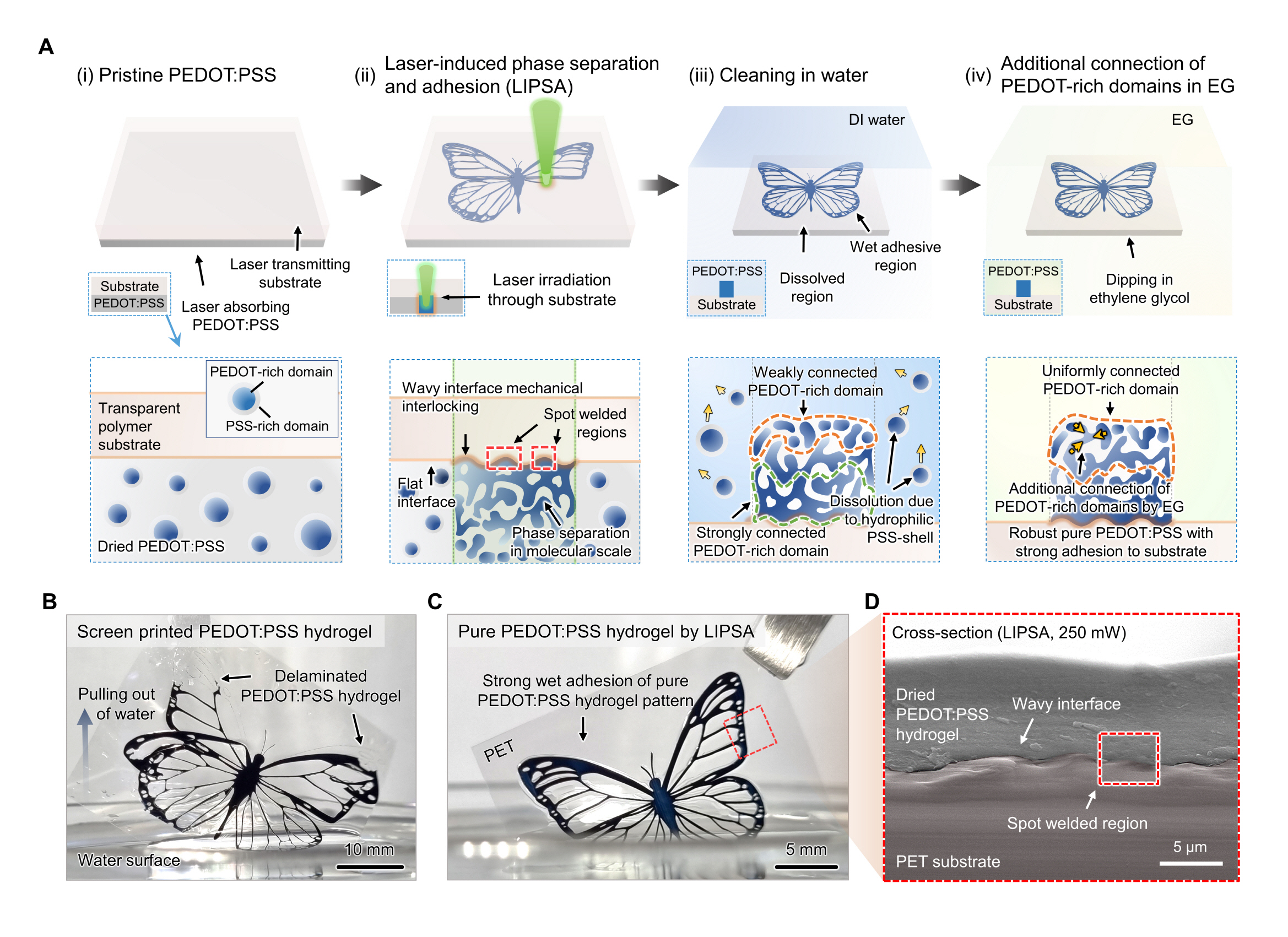Ultra-robust conductive hydrogels in microscale
Published in Materials
With fast innovation in connecting humans and machines such as implantable clinical applications and human augmentation, soft tissue-like devices that can be safely integrated into the human body are in the spotlight. Most of these soft electronics are based on polymeric materials, and in particular, the key component is electrodes that are directly interfaced with biological tissues for bio-signal recording and stimulation. It requires similar mechanical properties with soft tissues and high electrical properties simultaneously for effective signal transmission.
Conductive hydrogels hold great promise since they can contain high amounts of water with tissue-like low Young’s modulus and maintain their electrical conductivity in wet conditions. Generally, researchers have developed conductive composite hydrogels by blending conducting polymers with the crosslink-able hydrogel networks that serve as mechanical backbones. However, high amounts of electrically non-conductive elements led to low electrical conductivity normally below 10 S/cm. Recently, research has emerged focusing on phase separation of conducting polymer, especially poly(3,4-ethylenedioxythiophene):poly(styrene sulfonate) (PEDOT:PSS) to utilize the PEDOT:PSS chains as the main mechanical backbones. This approach has led to significantly improved electrical conductivity compared to composite hydrogels by increasing the proportion of conducting materials.
However, fabricating soft electronics using conductive hydrogels requires additional fabrication methods. Normally, solution-based techniques such as screen printing, 3D printing, and inkjet printing are used that are limited by low pattern resolution. High-resolution patterning is possible through photolithography, but it involves complex manufacturing processes with the preparation of expensive photomasks.
In a previous study (Won et al., Science Advances, 8(23), eabo3209), we reported that local phase separation of PEDOT:PSS occurred by irradiating a 532 nm continuous wave laser on PEDOT:PSS, thereby developing a conductive hydrogel-based soft bioelectronics without additional manufacturing process. However, since it is a composite hydrogel containing metallic NP and PVP chains, it not only lacks water contents but also exhibits relatively rigid characteristics. In addition, by practically using our hydrogel soft electronics for implantable in vivo applications, we faced several critical drawbacks of our previous process in terms of durability under repetitive mechanical stimuli. Most reported conductive hydrogels were also easily torn by repetitive mechanical stimulation (e.g., rubbing, bending, and stretching) due to their low modulus when fabricated into devices. More critically, due to the water-rich characteristics of hydrogels, they were easily delaminated from the substrates in aqueous environments that hampered long-term operation interfaced with wet tissues.

Figure 1. Laser-induced phase separation and interface interlocking structures for ultra-robust hydrogel patterning process. (A) Conceptual illustration of laser process. (B) Screen-printed PEDOT:PSS hydrogels easily delaminated from substrates in wet environments. (C) Laser-fabricated PEDOT:PSS hydrogels strongly adhered to substrates in wet environments. (D) Nano-and microscale interlocking structures at the interfaces.
Therefore, our group tried to improve previous research by not only enhancing the electrical and mechanical properties of conductive hydrogels, but also considering their practical usability. Can hydrogels, typically weak due to their soft and water-absorbing properties, be mechanically robust within the micro-scale domain? How can we address the easy delamination problem of hydrogel micro-patterns without complex and time-consuming surface treatments? We found the answer at the “interface” between the substrate and the PEDOT:PSS. We hypothesized that sufficient photo-thermal energy supplied at the interfaces could facilitate strong bonding between the two materials, accompanied by the phase separation of PEDOT:PSS. The next problem was to deliver enough photothermal energy to the substrate through the thick dark PEDOT:PSS, which absorbs light well in the entire visible range. The problem was solved quite easily. Since most polymeric substrates currently used for implantable or flexible devices transmit light in the visible range well, the dried PEDOT:PSS was flipped over and a 532nm laser was irradiated in the direction of the substrate. Photothermal energy by laser, which mostly penetrated the transparent substrates, was absorbed by PEDOT:PSS at the interface, and a strong bond was formed at the interface with nano-, and microscale interlockings. At the same time, local phase separation of PEDOT:PSS also occurred in the depth direction, greatly improving the stability of pure PEDOT:PSS hydrogel and its adhesion to the substrate.
Using the laser process, we could fabricate pure PEDOT:PSS hydrogel patterns that contain more than 80% of water on various substrates with 5 μm of resolution, which is higher than photolithography. These micropatterns were stably adhered to various substrates even under different types of mechanical stimuli (e.g., bending, rubbing, stretching, and even crumpling). To verify the effectiveness of our process, we also fabricated implantable bioelectronics with PEDOT:PSS hydrogel micropatterns that can stably record the brain and cardiac signals of rats. In addition, we used strong bonding and mechanical properties to allow ultrasonic cleaning of used electrodes. It was confirmed that it can be reused stably even after washing in harsh sonication cleaning.
More details on this study can be found in our recent article "Laser-induced wet stability and adhesion of pure conducting polymer hydrogels" published in Nature Electronics. (https://doi.org/10.1038/s41928-024-01161-9)


Please sign in or register for FREE
If you are a registered user on Research Communities by Springer Nature, please sign in